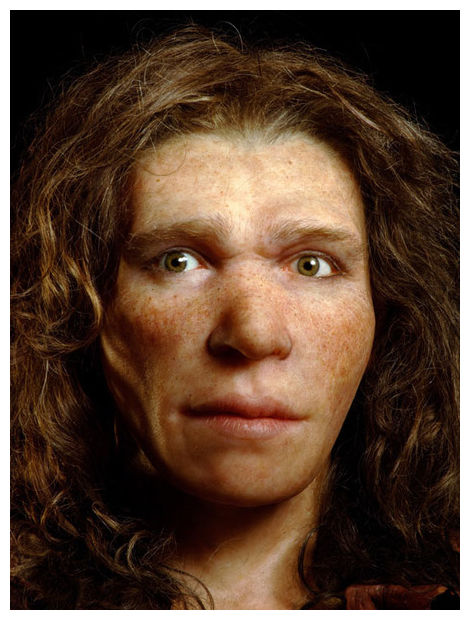
In museums around the world, reproductions of Neandertals sport striking blue or green eyes, pale skin, and gingery hair. Now new DNA analysis suggests that two of the most closely studied Neandertals - a pair of females from Croatia - were actually brown-eyed girls, with brunette tresses and tawny skin to match. The results could help shed new light on the evolution of the family that includes both modern humans and Neandertals, who died out some 30,000 years ago.
The study has provoked deep skepticism among several outside researchers, however, who criticize numerous aspects of its methodology. The results also run contrary to other genetic evidence and to a long-held hypothesis that Neandertals, who lived mostly in northern latitudes, must've had light skin to get enough vitamin D.
But even scientists who have doubts about the new research say it still provides food for thought. "Neandertals occupied a wide geographical range," says John Hawks of the University of Wisconsin, Madison, who was not involved in the study and who is also studying the physical traits of ancient humans, so "it's likely that they were variable in pigmentation. ... We are really at the first step."
The new study, to be published in the American Journal of Human Biology later this spring, looks at the genomes of three female Neandertals from Croatia. Their DNA was the basis of the first effort to compile a complete Neandertal genetic sequence, which was published in 2010.
The researchers focused their attention on 40 well-studied stretches of genetic material that help determine pigmentation in living people. A particular form of the gene known as TPCN2, for example, bestows brown hair in modern humans; any other form means hair that's another color.
One complication is that traits such as hair color are controlled by multiple genes. To determine the cumulative impact of multiple genes on one trait, the authors assumed they could simply add together the impact of individual genes. The female Neandertal known as Vi33.26, for example, had seven genes for brown eyes, one for "not-brown" eyes, three for blue eyes, and four for "not-blue eyes." By the researchers' reckoning, that means a six-gene balance in favor of brown and a negative balance for blue, so Vi33.26's eyes were probably brown. According to this method, all three Neandertals had a dark complexion and brown eyes, and although one was red-haired, two sported brown locks.
Study author Tábita Hünemeier of Brazil's Universidade Federal do Rio Grande do Sul says she's not surprised by the results. "There was a large population of Neandertals in Europe," she says. "It's impossible that an entire population has red hair or blue eyes."
She and her colleagues validated their technique, in part by applying to it the genomes of 11 modern humans whose photos and DNA are publicly available. Nearly 60% of the formula's predictions matched the subjects' actual physical appearance, the authors say. The team considers that accuracy rate satisfactory, given the complexity of the genetics behind skin color and other physical traits.
But experts caution against giving those museum exhibits a makeover just yet. The problem with the additive technique is that different genes have different levels of impact, says Carles Lalueza-Fox of Spain's Institute of Evolutionary Biology in Barcelona. In 2007, he authored a paper showing that two Neandertals, one from Italy and one from Spain, carried a genetic variation likely to bestow pale skin and red hair. He argues that some pigmentation genes have such a powerful effect that they override the combined contributions of many weaker genes - a phenomenon that would render the new study's simple gene addition inaccurate. The lighter skin color seen in Europeans, for instance, is due almost entirely to a single gene, he says. "We know that there are some genes that have a very strong effect" on physical appearance, he says.
Another problem, Hawks says, is that the study focuses on the effects of genetic variations found in modern humans. But Neandertals' hair and skin tones were almost certainly influenced by genetic variations unique to Neandertals, who were a species different from modern humans. So the study doesn't, and can't, consider many of the factors that would've influenced how Neandertals looked.
Hünemeier responds that her team looked for new genetic variations unique to Neandertals and other ancient humans and came up empty-handed. She also says that other recent work confirms that it's possible to compute the impact of large numbers of genes using simple arithmetic.
Although Hünemeier and her critics differ on the methods her team used, they agree that the stereotypical view of Neandertals is too narrow. Lalueza-Fox says Neandertals probably had brown eyes and a variety of hair colors, and Hawks thinks Neandertals living in places such as Israel may have had darker skin than their European counterparts.
The uncertainty may not last much longer. Hünemeier and her critics alike think the growing trove of information about the DNA of ancient humans will soon reveal Neandertals' true colors. New genetic information is being generated on "hundreds of individual paleopopulations," Hünemeier says. "In 5 years we will have an ocean of information to study."



Reader Comments
to our Newsletter